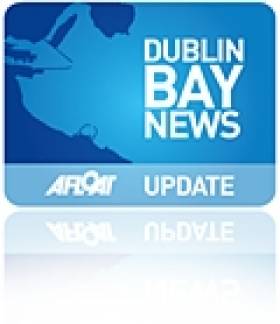Displaying items by tag: Dun Laoghaire Harbour and news
Renovated Former Mariners Church Open to All
#OPEN HOUSE- The National Maritime Museum of Ireland is to participate in the Open House Dublin weekend in early October, writes Jehan Ashmore.
The former Old Mariners Church was built between the years 1838-1867 for the Church of Ireland, though the architect is unknown. Its construction involved granite rock quarried from Dalkey Hill.
In June of this year the museum was reopened following several years of extensive renovations and a subtle refurbishment which was carried out to ensure its impressive collection can be showcased.
Among the exhibits is a model of the RMS Leinster which was torpedoed off the Kish during WWI with the loss of 500 people. A notable display is an optic from the Baily Lighthouse on Howth Peninsula. It was installed in 1902 and removed in 1972 when the lighthouse was modernised. Also on view is a uniform of Captain Robert Halpin, who was master of the Great Eastern which laid the first successful telegraph cable across the Atlantic from Ireland to the US.
The museum is located on Haigh Terrace, off George's St. Upper, the main street in Dun Laoghaire. Facilities include a coffee dock, a Wi-Fi hotspot and museum shop. Most of the museum is wheelchair accessible.
No booking is required and opening times on Sunday 7th October are 12noon-4.30pm. For information and links to other buildings in the Open House Dublin programme click HERE
Courtown Harbour Rowing Club took second place in a time of 3:3:19 and third place honours went to Stella Maris Rowing Club with a time of 3:16.00. The hosts of the Hobblers Challenge, St. Michaels Rowing Club based out of the Coal Harbour, passed under the high walls of the East Pier Lighthouse and battery some two minutes later in fourth place.
The annual event (for race-route click HERE) was only re-introduced onto the race calendar last year after a break of several years. The skiffs were launched at the Coal Harbour slipway where they headed over to line-up for the starter's gun opposite the Hobbler's Memorial located on the publicly accessible Eastern Breakwater which is between the Stena Line HSS fast-ferry berth and the Dun Laoghaire Marina.
In attendance to greet the start of the race in memorial of the Dublin Bay hobblers was the RNLB Anna Livia of the local RNLI lifeboat station. The bronze memorial depicts a tower of lifejackets in commemoration of three young Dun Laoghaire hobblers who after piloting and unloading the schooner Jealous of Me in Ringsend, failed to return home.
This occupation was carried out by men also from Ringsend, Dalkey and other harbours and it was the first crew to reach a ship and throw a hook on the deck who would win the business of pilotage and unloading in Dublin Port.
Crews would think nothing of rowing out to the Kish Bank on the hope of spotting a ship. If they waited offshore and no passing trade appeared along the East Coast the craft doubled as a bed if it became too late to row home. The craft were much larger and heavier compared to the present day skiff and it is in these oarstrokes that the Hobblers Challenge follows the original race of the hobblers during the 18th and 19th centuries.
It was apt that on the same day of this year's Hobblers Challenge, the 107-year-old ketch Bessie Ellen, a former cargo-carrying vessel that represented one of the last such sail-trading ships operating in the Irish Sea, was making a passage to the east of the Kish Bank.
To read more about the un-manned Kish Lighthouse click this HERE, and for the 150 cargo tons capacity ketch built in 1904 click HERE.
- Dublin Port
- Fishing
- Dun Laoghaire Marina
- Dublin Bay News
- Irish Lights
- Dun Laoghaire Harbour
- Kish Bank
- Ferry news
- Stella Maris Rowing Club
- Kish Lighthouse
- East Coast skiffs
- Dun Laoghaire Harbour and news
- Stena Line HSS Dun Laoghaire
- Hobblers Challenge
- Dublin Bay pilots
- Rowing news
- Coal Harbour Dun Laoghaire
- St. Michaels Rowing Club
- Courtown Rowing Club
- St.Patricks Rowing Club
- Ringsend skiff clubs

























































